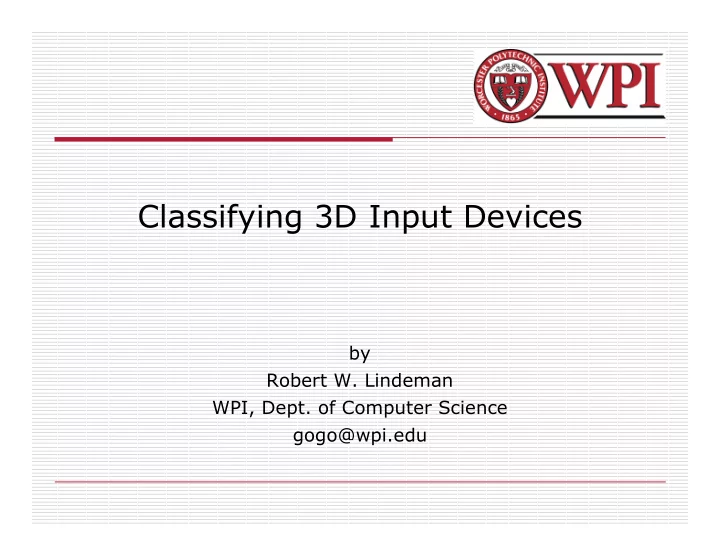

Classifying 3D Input Devices by Robert W. Lindeman WPI, Dept. of Computer Science gogo@wpi.edu
Motivation � The mouse and keyboard are good for general desktop UI tasks � Text entry, selection, drag and drop, scrolling, rubber banding, … � Fixed computing environment � 2D mouse for 2D windows � How can we design effective techniques for 3D? � Use a 2D device? � Use multiple n- D devices? � Use new devices? � Use 2D interface widgets? � Need new interaction techniques! R.W. Lindeman - WPI Dept. of Computer Science 2
Motivation (cont.) � Gaming and Virtual Reality � Tight coupling between action and reaction � Need for precision � VR can give real first-person experiences, not just views � Head-mounted Display � In order to look behind you, turn your head! � Selecting/manipulating an object � Reach your hand out and grab it! � Travel � Just walk (well, not quite)! � Doing things that have no physical analog is more problematic R.W. Lindeman - WPI Dept. of Computer Science 3
Common Input Devices Mouse Keyboard Joystick TrackBall TrackPoint TouchPad MightyMouse Tablet R.W. Lindeman - WPI Dept. of Computer Science 4
Game Controllers PlayStation2 (2000) Atari 2600 (1977) Revolution (2006?) Intellivision (1980) Xbox 360 CLIP (2005) Source: http://www.axess.com/twilight/console/ R.W. Lindeman - WPI Dept. of Computer Science 5
Classification Schemes � Relative vs. Absolute movement � Integrated vs. Separable degrees of freedom � Digital vs. Analog devices � Isometric vs. Isotonic devices � Rate control vs. Position control � Special-purpose vs. General-purpose devices � Direct vs. Indirect manipulation R.W. Lindeman - WPI Dept. of Computer Science 6
More on Classifications � Relative vs. Absolute movement � Mouse vs.Tablet � Integrated vs. Separable degrees of freedom � Mouse has integrated X, Y control � Etch-a-sketch has separate X, Y control � Motions that are easy with one are hard with the other � Analog devices allow more sensitivity � For example, analog game controllers R.W. Lindeman - WPI Dept. of Computer Science 7
Isometric vs. Isotonic Input Devices (Zhai) � No motion vs. No resistance � Actually a continuum of elasticity � TrackPoint (mostly isometric) vs. mouse (mostly isotonic) � Many devices are re-centering ( e.g. , joysticks) R.W. Lindeman - WPI Dept. of Computer Science 8
Rate Control vs. Position Control (Zhai) � Mouse is normally used for position control � Mouse scroll-wheel � Position control � Click-drag for rate controlled scrolling � Trackballs typically use position control � Joysticks: Control position (cross-hair), or Control velocity (aircraft) � Rate control eliminates need for clutching/ratcheting � Isotonic-rate control and isometric-position control tend to produce poor performance (Zhai) R.W. Lindeman - WPI Dept. of Computer Science 9
Special-Purpose vs. General- Purpose Input Devices (Buxton) � Game controllers are designed to support many types of games � Game developer decides on mapping � No "standard" mappings -> each game different � Some special-purpose devices exist � Light guns � Steering wheels � RPG keyboard/joystick � Drum kits, dance pads, bongos, etc. R.W. Lindeman - WPI Dept. of Computer Science 10
Direct vs. Indirect Manipulation � Direct � Clutch and drag an icon with mouse or stylus � Touch screens, PDAs use direct manipulation � Works well for things that have a physical analog � Indirect � Use some widget to indirectly change something � Problems with direct manipulation � Some things do not have a physical analog � Precision may be lacking � Selection/de-selection may be messy R.W. Lindeman - WPI Dept. of Computer Science 11
3D Input Devices SpaceBall SpaceMouse CyberGlove II HMD with 3-DOF tracker PHANTOM Omni Haptic Device Tracked Paddle for 2D Interaction R.W. Lindeman - WPI Dept. of Computer Science 12
Other Options � Some alternatives � Speech � Gestures: pointing to fly � Device actions ( e.g. , buttons, joysticks) � Head/gaze directed � Hybrid � Speech and gesture ( e.g. , "Put that, there.") R.W. Lindeman - WPI Dept. of Computer Science 13
Mapping Devices to Actions � For each (user, task, environment) � For the four basic VR tasks � For each device DOF � Choose a mapping to an action � We also need to easily switch between actions! R.W. Lindeman - WPI Dept. of Computer Science 14
Placing Devices in Context � Table? Device Rel/Abs Int/Sep Dig/Ana Isom/Isot Rate/Pos Spec/Gen Dir/Ind Mouse Relative Integrated Digital Isotonic Position General Both Glove Absolute Integrated Isotonic … … … R.W. Lindeman - WPI Dept. of Computer Science 15
Verification and Comparison � Framework for user studies � Interesting to fill in the empty spaces � Isotonic position control for rotation? � Other novel combinations? � Very active field right now � ACM CHI, IEEE VR, 1st 3DUI Symposium ACM SIGGRAPH R.W. Lindeman - WPI Dept. of Computer Science 16
More Info � Shumin Zhai at IBM Almaden � Bill Buxton at U. of Toronto (Alias|Wavefront) R.W. Lindeman - WPI Dept. of Computer Science 17
Recommend
More recommend